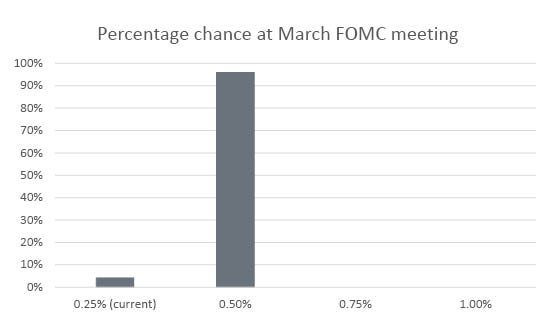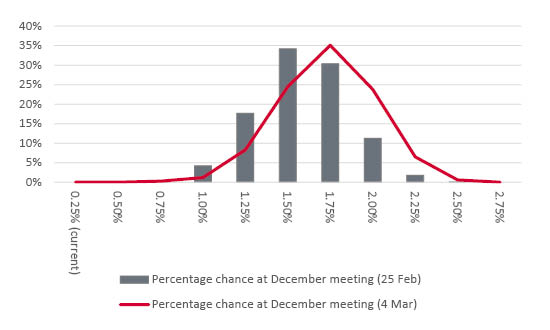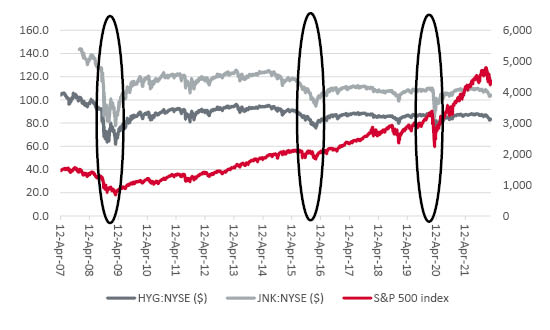


No-one, but no-one, knows what the ultimate ramifications of Russia’s invasion of Ukraine will be, looked at from the broad perspective of international politics or the much narrower – and less important – one of investments. Commodity markets are in turmoil but stock and bond markets are so far keeping relatively cool, perhaps because they just do not know what to make of it, perhaps because they think a diplomatic solution is still possible and perhaps because they still feel (or hope) Western central banks have their back.
Why that would be when central banks cannot print oil or copper or wheat is an interesting question (and is itself an explanation for why those commodities are soaring). But markets are beginning to reduce their expectations for the number of interest rates that the US Federal Reserve may push through in 2022.
Fed chair Jay Powell last week (3 March) seemed to confirm that the meeting on 16 March will see a quarter-point increase, no more. A month ago, markets were putting a 50%-plus chance on a half-point rise whereas now some even think there is a small chance that the US central bank will do nothing.
“A month ago, markets were putting a 50%-plus chance on a half-point rise whereas now some even think there is a small chance that the US central bank will do nothing.”
Markets are pricing in a quarter-point hike from the Fed on 16 March

Source: CME Fedwatch, Friday 4 March 2022
The view seems to be that higher energy and commodity prices will bump up inflation and in turn hit consumers’ (and corporations’) ability and willingness to spend. That will slow the economy and take out some of the heat from inflation, with the result that rates will not need to go up as far or quickly as expected. Markets are now pricing in five rate hikes from the Fed in 2022, down from seven, according to the CME Fedwatch service.
US rate rise expectations have ratcheted back

Source: CME Fedwatch, Friday 4 March 2022 and Friday 25 February 2022
“An end to the fiscal stimulus so liberally applied during the pandemic and the withdrawal of monetary stimulus surely makes some kind of slowdown inevitable anyway, after the sharp bounce back as lockdowns ended. The question now may be how abrupt that slowdown becomes – with the Russian invasion getting the blame.”
An end to the fiscal stimulus so liberally applied during the pandemic and the withdrawal of monetary stimulus surely makes some kind of slowdown inevitable anyway, after the sharp bounce back as lockdowns ended. The question now may be how abrupt that slowdown becomes – with the Russian invasion getting the blame. The Atlanta Fed’s GDP Now forecast suggests potentially very, as the service’s estimate for Q1 GDP growth in the USA is precisely zero.
That may leave central banks with a dilemma, as they face a choice of letting their economies take a hit from inflation or a hit from higher interest costs. One way in which stock market investors can assess the potential implications of this tricky choice is to look at high yield (or ‘junk’) bonds.
High yield is the technical term for non- or sub-investment grade debt. It is tradeable debt (bonds) issued by companies that carry a rating of BB or lower from agencies Standard & Poor or Fitch, or Ba or lower from Moody’s.
Generally, these are firms with a lot of debt and potentially troubled operating models where there is a higher risk of default, either through the non-payment of a coupon at the pre-agreed time in the pre-agreed size, or the failure to return the investor’s principal (or initial investment) in full.
Owing to this risk, “junk” debt tends to come with a higher coupon than investment grade corporate debt or sovereign (Government) debt, as potential buyers demand higher rewards to compensate themselves for the greater dangers.
High yield debt also tends to trade more like equity, since an economic upturn will be good news, in the shape of more profits, improved cash flow and a reduced risk of default. A recession is usually bad news indeed for high yield debt prices, as investors flee, thanks to the prospect of lower profits, less cash flow and the increased risk of default.
As a result of that, high yield is often seen as a lead indicator for equities. The asset class can be followed quickly and easily by checking out the prices of two US-listed Exchange Traded Funds, the SPDR Bloomberg High Yield ETF (JNK:NYSE) and the iShares iBoxx High Yield Corporate Bond ETF (HYG:NYSE).
Junk bond prices are sagging

Source: Refinitiv data
“The HYG product trades at $83.3 at the time of writing. If history is any guide – and there are admittedly no guarantees on that front – there could be trouble ahead for the economy and share prices if it goes below $80.”
The good news is that neither is collapsing. The bad is news is that the price of both high-yield ETFs peaked last autumn and they now stand some 5% to 6% down from their highs. The HYG product trades at $83.3 at the time of writing. If history is any guide – and there are admittedly no guarantees on that front – there could be trouble ahead for the economy and share prices if it goes below $80, either in the form of a recession or even stagflation.
Past performance is not a guide to future performance and some investments need to be held for the long term.
This area of the website is intended for financial advisers and other financial professionals only. If you are a customer of AJ Bell Investcentre, please click ‘Go to the customer area’ below.
We will remember your preference, so you should only be asked to select the appropriate website once per device.